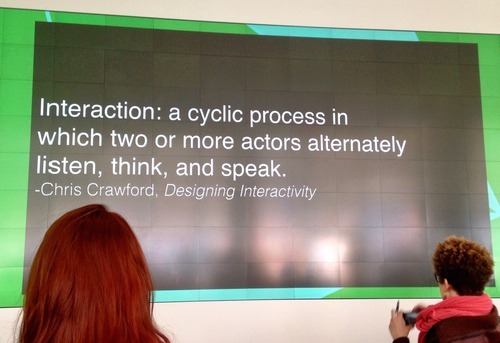
I spent a large portion of last week at Tribeca Hacks Mobile, Tribeca Storyscapes and TFI Interactive. In fact, I was so busy at those events (and before that working on two commercials and before that spending Passover with my family in Pennsylvania and before that not actually knowing that the festival had started, oops) that I didn’t make it to any of the rest of the Tribeca Film Festival, in spite of the fact that there were films there that I wanted to see, including some by folks I know. But I guess that’s indicative of where my head is at these days: focused more on thinking about interactive storytelling and everything that entails (or could) and less about traditional filmmaking.
I can’t say it’s easy for me to switch gears, change horses, jump tracks, fill-in-your-own-dying-technology-metaphor-here. I’ve been in the “traditional” realm of storytelling for a while and it’s a little difficult — okay, a LOT — to shake my brain loose from that way of doing things. Let the audience pick the direction of a story? Let them generate their own content that we can not only share but also maybe represent on a map or a graph? Er, is that a game? Is it an infographic? What the heck IS that?
Yeah, letting go is hard — of what you thought you knew, of believing you’re good at a kind of storytelling that you thought was going to be leading us into future rather than maybe getting left behind, of control of the story itself. And while giving up that control is something several people talked about in their presentations at TFIi on Saturday, it’s easier to look at in the abstract and nod your head and say, “Oh, that’s cool, oh totally,” than to actually do when it comes to your own work. Being part of a Tribeca Hacks team was a good exercise in letting go, not only because every other person on my team was sort of a multipath tech/design rockstar who could code, but because you have to give up a lot of control to work with a group of four other people who have just as many ideas as you do if not more. It’s amazing our team and three others managed to come up with cool and executable ideas for interactive mobile storytelling in 32 hours and didn’t just implode from the mass of all of those egos and brains trying to converge under pressure on to one workable concept (as the fifth team sadly did).
It’s invigorating to be around so many people trying to figure out how to blend/smash all of this potential for storytelling and interactivity together and bake it into something new. A lot of the projects I’ve seen so far seem like they emerged primarily from one realm — film & journalism or games or tech — but haven’t quite integrated the others. But I find what’s not being done yet as encouraging as what is, because it means the gatekeepers are few and there is no one right way right now, that there are so many avenues to explore and so much left to do that I know there’s a place for me, which is especially comforting given how I’ve been questioning my place in the traditional film business.
And though, true, I didn’t make it to the rest of the festival, I was kind of surprised I didn’t see more filmmakers from the rest of the festival at the interactive events. Yes, I know of what a festival is like for people who go there with their films, it’s crazy with parties and shmoozing and trying to sell yourself and your project, and if what you’re looking for is a distribution deal for your current film or money for your next one, you’re probably not seeing any reason to waste your time elsewhere. (For the record, the parties on the interactive side were good too, especially if you like gin, which was flowing generously at the Bombay Sapphire House of Imagination and was also all they were serving). But I think any filmmaker would have benefited from seeing the amazing things that the storytellers who are starting to blur the lines between these media are making. It made me think a lot, and what creative person couldn’t do with more thinking?
A number of the filmmakers I did see were other women, minorities, and LGBT folks. That partly reflects the curation of the organizers at TFI, of course, and they should be given credit for promoting diversity at the event through the projects and the presenters they chose. But I think that’s not entirely why they had that kind of turnout. Sure, one could see it as ironic, since we all know that if there’s one area that’s less hospitable than film to those who aren’t white and male and straight, it’s tech. But from another perspective it makes perfect sense, especially given the conversations I had with those filmmakers about how frustrated we all feel with the film industry, and how we’re looking for where else we can go with what we do, what we think about, and what we think we can do.
I guess I’d like to believe that those of us who don’t see ourselves in film or tech are forced by our outsider status to be innovative thinkers who want to combine the two. Frustrated with what we’ve experienced in the land of traditional media and looking for a new place that will welcome us, we’re seeking out what’s next. As an atheist Jew I wouldn’t say I have much in common with the Pilgrims or the Mormons, but I understand now how when you aren’t welcome where you are, you decide to strike out on the frontier. Maybe you’ll find a new world. Or Utah.
